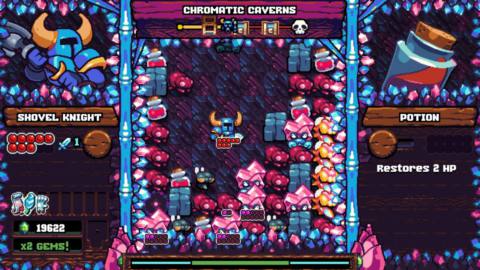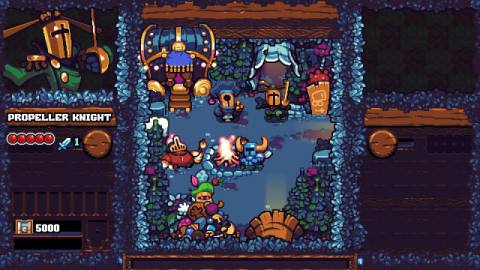
Shovel Knight Pocket Dungeon launches tomorrow and offers an intriguing change of pace for everyone’s favorite shovel-wielding hero/obligatory indie cameo star. After countless matches, I can say its action-oriented spin on tile-matching puzzle games works well. Assuming you can put up with a surprisingly steep difficulty curve, Pocket Dungeon is worth checking out if you’re looking for a new puzzler to chip away at.
Pocket Dungeon’s boards feature descending tiles, which can be monsters, obstacles, health potions, and other items you must prevent from stacking to the top by clearing matching tiles adjacent to another. You move Shovel Knight (or other unlockable characters) within these boards to bash away matching titles. Though tiles automatically descend slowly to start, they drop faster each time you move. Furthermore, both you and monsters have health bars, and most foes hit back after being struck. Losing health results in failure, so Pocket Dungeon becomes a tricky balance of clearing tiles relatively quickly while thoughtfully attacking foes to avoid getting killed yourself. Tile-clearing also rewards gems used to purchase new items and fills up a meter that multiplies your gem intake.
Click here to watch embedded media
As a fan of tile-matching games, Pocket Dungeon’s more action-oriented approach took getting used to. Honestly, I still haven’t mastered it. Early on, I instinctively bashed into every matching stack of monsters I saw, forgetting I often took the same damage in return. Depending on the mode of play you choose, traditional or roguelike, dying has two results. Playing traditionally grants unlimited lives, so you only lose when the board fills up. Playing under roguelike rules means you start from scratch after each death, regardless of the board’s state. I’m playing the traditional format, but I’d describe it as “less hard” rather than easy, per se. Sure, Shovel Knight can die repeatedly, but respawning takes precious seconds, and the game doesn’t wait for you to return. By the time you’re back, the board may have filled up, resulting in failure. This taught me to always monitor my health and judge the right times to attack.
You don’t need to wipe a board clear to win. Finding keys to open exit doors advances you to the next stage, so it’s really about surviving until said door appears. Keys also open chests that grant useful power-ups such as a spear that pierces multiple targets, a shield that blocks attacks, or a smokescreen that negates enemy counterattacks within a perimeter. My favorite is a simple bomb that clears large chunks of tiles, though it can damage you as well if you don’t escape its range.
Shovel Knight Pocket Dungeon is challenging. Since tiles descend faster when you move (and drop slower when you’re stationary), quelling the knee-jerk desire to plow through as quickly as possible is tough and can result in a hasty death. This is especially true against enemies that require more thought to eliminate, such as ghosts that vanish for a period after each hit or frogs that become electrified every other step. Managing multiple enemy types that all require their own approach to defeating them isn’t easy. I took quite a few beatings before finally finding a groove. Now, I can carefully navigate a board while still acting quickly. Clearing 10+ blocks of a nasty enemy feels immensely satisfying.

Even still, I think the difficulty spikes earlier than it should. Stage 1 serves as a fine introduction with basic enemies, making it easy to grasp the mechanics. However, Stage 2 tosses in shield-bearing foes who must be attacked from multiple directions since they block the angle you struck them last. It’s a tricky idea to wrap your mind around so early into the game, and it feels like it should have been saved for the 3rd or 4th stage minimum. I hit a wall early on because of it. I worry others will, too, and bounce sooner than later.
Failing a stage means starting back from Stage 1, but thankfully you can eventually purchase a fast-travel option to immediately revisit your stage of choice. In between runs, you’ll hang out at a base camp to purchase helpful items from a rotating shop inventory. Useful perks include a longer-lasting gem meter or gaining more hit points. I also enjoy engaging in NPC distractions such as a reflex-based tile hitting challenge.
Shovel Knight Pocket Dungeon continues to evolve, and overall, I’m having a good time seeing what devious tricks it has in store. The pixel art looks unsurprisingly great, and the soundtrack is as bop-worthy as you’d expect from a Shovel Knight joint. I’m also getting my metallic butt handed to me less, but the game remains an uphill climb in terms of challenge. Shovel Knight’s puzzling block experiment is shaping up to be a fun, though often swear-inducing, success.
Shovel Knight Pocket Dungeon will be available on PlayStation 4, Switch, and PC.
